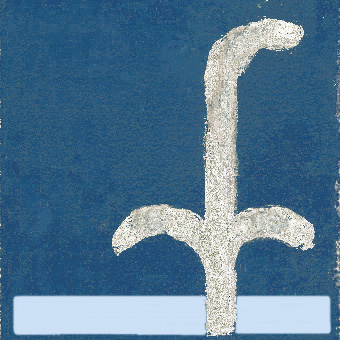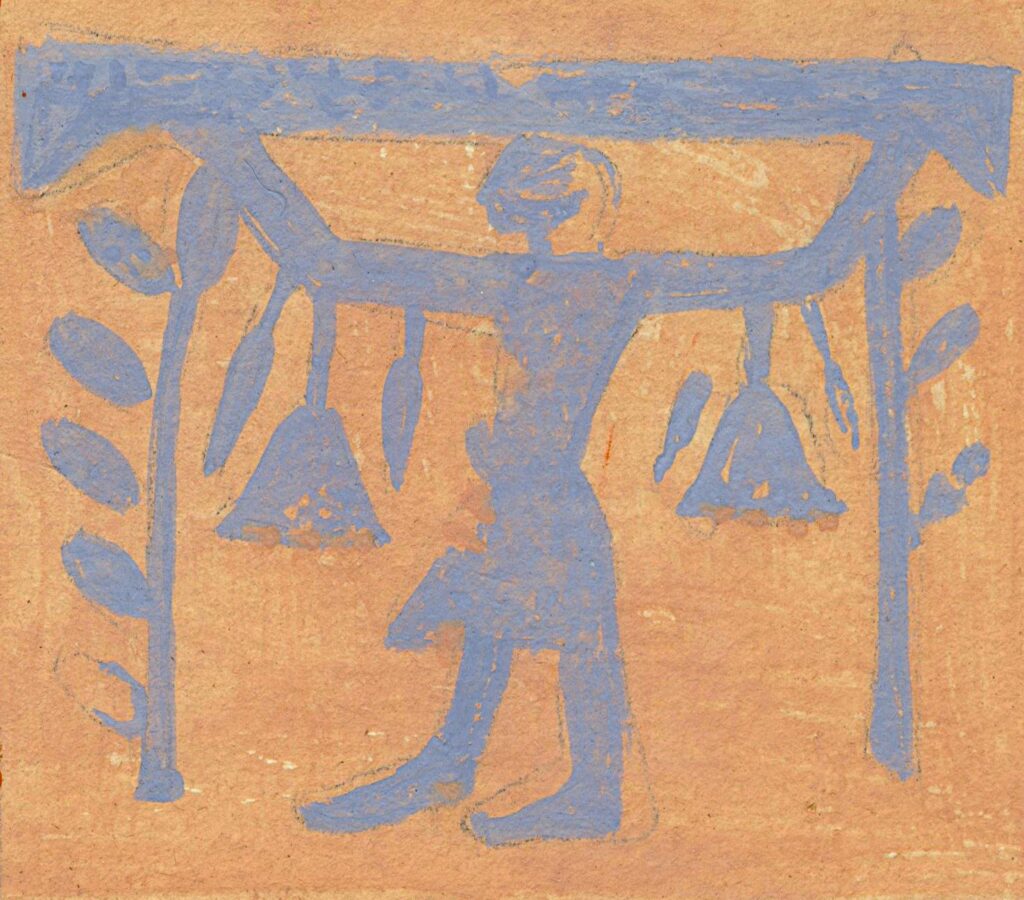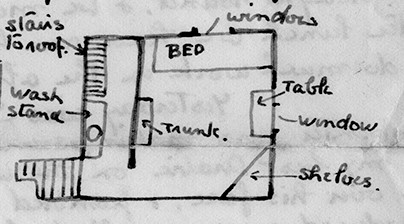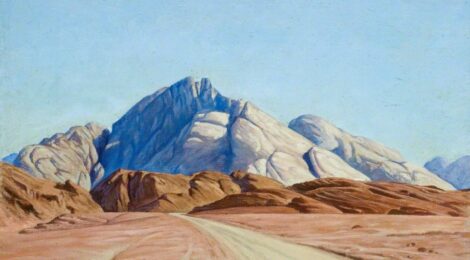
Water – 1
Author: Susan Biddle.
This post is the first of four looking at water, and focuses on the team’s personal washing arrangements at the Abydos dig-house and when trekking in the desert.
Myrtle’s earliest letters home are filled with domestic details, giving her mother and readers today a vivid picture of the practicalities of life in the dig house. There was a well but no running water, so they depended on Semman, the water carrier. An early letter included a sketch of Myrtle’s tower room in the dig house, including her washstand.
Later Myrtle’s bedroom washing arrangements became more sophisticated. In 1934 she made a towel rail with palm sticks, sending her mother a sketch of the design and telling her that it was “very easily made from odd bits”. The following year she told her mother that she had “fixed a shelf in the corner over my washstand & there is an enamel plate on it for sponges & a hook from which my face cloth hangs, & room for nail brush etc so everything is handy & tidy”.
Although Myrtle Broome and Amice Calverley’s seasons in Egypt did not start until October or November, it could still be very hot. Fortunately they were able to take a daily bath. Myrtle explained to her mother in October 1929 that, when she returned from the Temple of Seti I in the evening, “my clothes are all wet through”, but reassured her that “I don’t feel in the least distressed; as soon as we get in, we all have hot baths. That means a large copper bowl big enough to sit or kneel in is placed in our room, also a large can of hot water & ditto of cold, so we are able to get a really good sponge down”. The bath water had to be heated on wood fires; if hot water was required in the morning, it was heated in kettles on the primus.
Many of Myrtle’s accounts of a day trip end with a reference to the pleasures of a bath, even if it was only in the large copper bowl in her bedroom. After a picnic up a wadi and sliding down a “sand glacier” with a visitor in November 1929, she told her father: “we came home by starlight & weren’t we just glad of hot baths & clean undies when we got in”. Arriving home just before dusk in April 1933, after a camel ride to another picnic in a wadi and “clamber[ing] up the cliff to some old stone quarries” full of bats, Myrtle “was very glad to have a hot bath & do a little anointing. Hot weather makes one tender in spots”. In January 1930 Myrtle and Amice rode 22 miles by camel to Nag Hammadi to see the new dam, arriving “very stiff & sore”. Myrtle explains in her letters back home that the wife of the chief engineer “was a dear, she insisted on ordering hot baths for us”; they “each had a glorious hot bath with vinegar in it & doctored each other’s sore patches with cold cream”. When Myrtle arrived in Cairo at 7 a.m. after an overnight train journey from Baliana at the end of her first season, her priorities were “breakfast & a gorgeous hot bath”.
By 1935 she had learnt some useful tricks, telling her mother that she had “found it is very refreshing to put a few drops of Eau de Cologne on my sponge when I have my bath”. She suggested her mother to “try it on your face flannel, it makes you feel so fresh & helps take the tired feeling away. It is a little luxury one appreciates very much out here”.
Towards the end of the first season, Amice and Myrtle, together with a guide and some of the servants, rode camels across the Western Desert to the Kharga Oasis. Myrtle said to her mother: “needless to say we do not intend to wash on the journey”. When they arrived at the government rest house in Kharga after four days trekking and camping in the desert, they found “2 bedrooms, each with two beds, chairs & washstand & pegs to hang clothes on”. Their “first demand was for hot water, we had a glorious wash all over, & got into real clean clothes & felt like giants refreshed”.
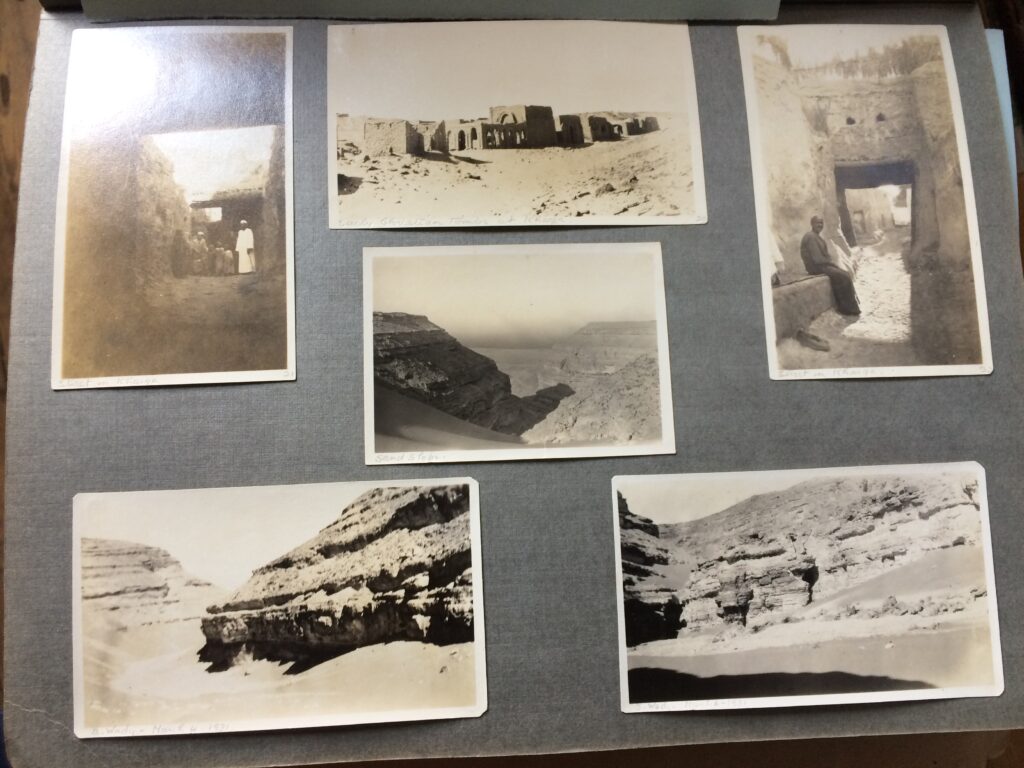
Photographs © Myrtle Broome (1930). Photograph by Susan Biddle (2022)
Bushey Museum and Art Gallery
The facilities at some of the rest houses were basic. At Kasr in the Dakhla Oasis, which Myrtle visited in March 1935, there was “only a bare room, with a camp bed & wash bowl in it”. She told her mother that this “would have been all I needed”. However, when he heard that she planned to stay there, the omdah [headman] of Gedida, another village in the oasis, had insisted that she return to his house so she could be “properly looked after”, as he considered that the rest house at Kasr “was only a bare room for soldiers”. She did not recount what greater facilities were provided at the omdah’s house.
Visiting Beris at the end of the same trip, Myrtle stayed at the police outpost in the room kept for police officers, government officials, and privileged travellers. This “contained two camp beds, a camp chair, a washstand & a strip of matting. Bedding consisted of a mattress, a hard bolster sort of pillow & a blanket & a mosquito curtain, every thing clean & in good order”. The police sergeant “was overwhelmed at having to entertain an English lady”, and Myrtle describes: “his eagerness to serve me was almost embarrassing. He wanted to act as lady’s maid. He insisted on pouring water while I washed. … I finally got rid of him by telling him I wished to change my clothes. At that he retired, & I was able to have a proper wash”.
Myrtle was quite prepared to “rough it”, but even she modified her holiday plans in March 1934 “as the hot weather has set in very early this year & this would make it hard for camels to go 4 or 5 days without water & I don’t know if I should enjoy going all that time in a state of sweat & no possibility of a wash until I got back”. Instead of trekking to a cave decorated with hieroglyphs on a two-day camel ride into the desert, she based herself with Charles and Betty Oulton, friends in Sohag, and did a series of day trips. As she told her mother, this had the great advantage that “when I do get back to Betty’s, there will be a bath”.
While based with the Oultons, she did make one three-day trip, accompanied by Sardic, the head servant, and the Sudanese sergeant who was one of the three members of the camel patrol guarding the dig house. After sleeping on a divan on the veranda of a village meeting house for the first night, on the second night they camped near the village where her first Arabic teacher lived. Myrtle explained to her mother how she washed on these occasions: “Ablutions in the desert are rather amusing. Sardic brought the water in an earthernsic pitcher (borrowed from the well) & poured it in a little trickle while I slouched [sluiced?] my hands & arms & face & as much of my neck as such publicity permitted”. On this occasion, just as Myrtle finished drying herself and was combing her hair, her Arabic teacher and his uncle arrived to wish her good morning, leaving Myrtle no option “but to receive them in my nightie & dressing gown!!”. When her visitors sent to greet Sardic and the sergeant, she “seized the opportunity & quickly got into my frock & completed my toilet behind my sunshade”. She returned to Sohag in time for tea that day where, once again, she “did enjoy the luxury of a bath”.
Washing on their desert trips sometimes presented unexpected challenges. In March 1936, Amice and Myrtle drove across the Eastern Desert to the Red Sea coast where they camped by the sea.
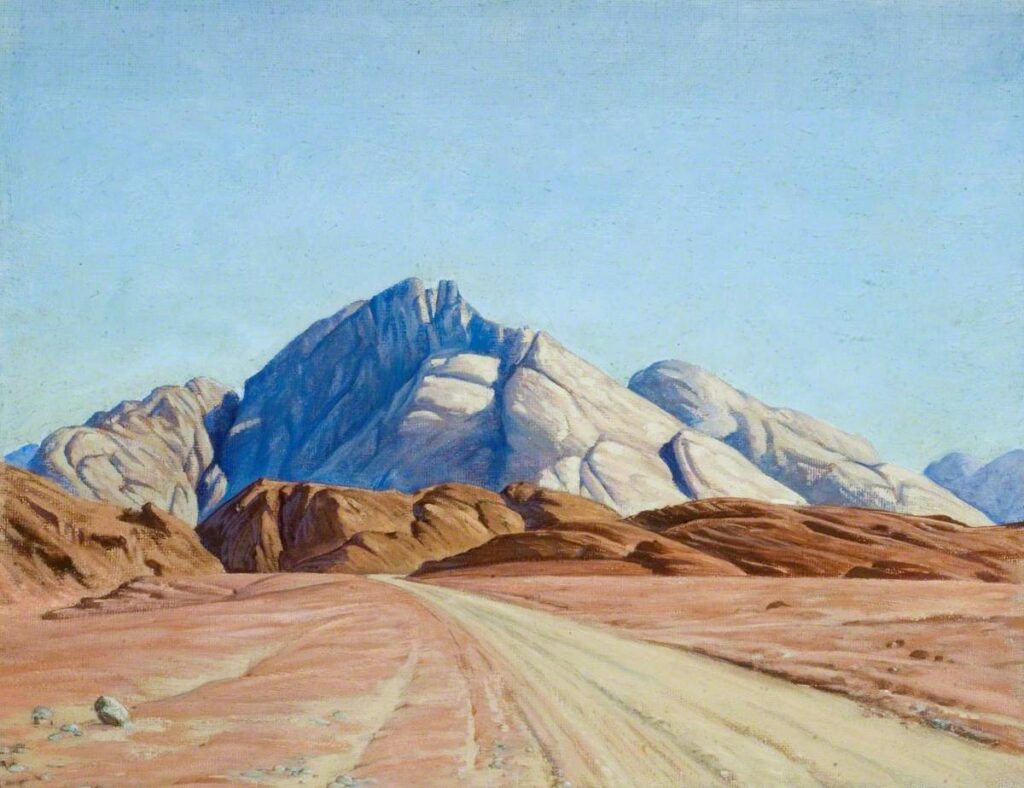
© Myrtle Broome (date unknown)
Bushey Museum and Art Gallery
Myrtle told her mother that when they returned from a pre-breakfast swim, Sardic “had an amusing incident to tell us. A raven had seized Amice’s sponge bag complete with contents & was flying off with it dangling from his beak. Sardic shouted & threw stones at him & scared him so that he dropped it”. Myrtle wished they had seen this and wondered whether the raven “would have eaten the soap & tooth paste & made a nest with the sponge”. Unsurprisingly, “Amice was very glad it was retrieved”. After a few days on the coast, they had a two-day drive back across the desert to Nag Hammadi; they stayed the night with friends “in great luxury”, Myrtle once again emphasising: “we did enjoy our baths”.
Sources:
Letters: 33, 34, 41, 52, 61, 65, 88, 115, 202, 231, 279, 284, 285, 303, 329, 330, 349, 357, 372, 373.
With thanks to:
- the Griffith Institute, University of Oxford, for the opportunity to work on the Broome collection, and for their ongoing support for this blog
- the Bushey Museum and Art Gallery, for Myrtle Broome’s painting and for access to Myrtle Broome’s photograph albums
